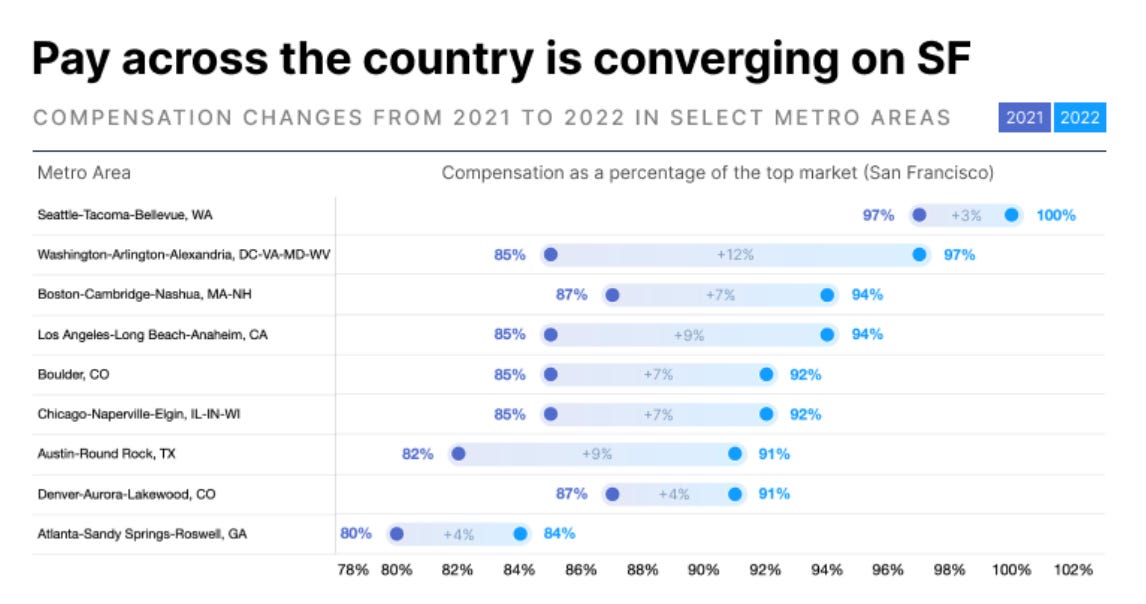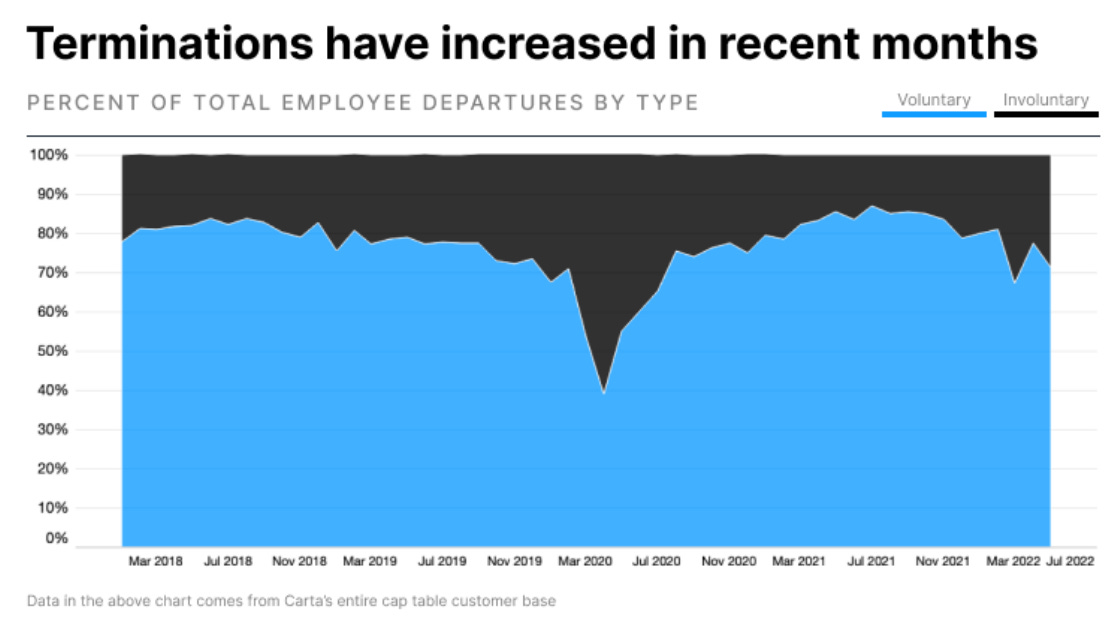| 👉 Hiring: Why More is Often Less (Ravi Gupta) ❓ Why am I sharing this article? How many great coaches do we have? It should constraint our hires in communities. Can we make that assessment? Match people with problems (not role with problems). When hiring, focus on the ability to get things done without a lot of direction. The best people are not available, you need to chase them! You need to earn their interest in your company. It requires extreme patience and a high pain tolerance. The solution is not more people. It’s more trajectory-changing people.
“I have no idea how many great managers we have, so I have no idea how many people we should hire. The constraint on hiring should be how many great managers you have. Figure out how many managers you would clone and give them as many people as they can handle.” Make a list of the best people in your company. Note whether they are a manager or individual contributor. Write down what they are working on. Confirm that those people are working on the most essential thing in your company and are overloaded with responsibility. If you decide you still need to hire and partner with internal or external recruiters, have them meet your best people. Spend real time trying to understand and articulate why you like them so much. I would bet it has something to do with their ability to get things done without a lot of direction. You might end up with a much different job spec than the one you have (the one with twenty bullet points).
Take time to go and hunt great people. The best people are rarely available. Why would they be? They are probably superstars in their current job too. They aren’t just going to show up in your interview slate. You gotta go get them. Ask your recruiter (and everyone you know) who the best people are. Then go meet them and earn their interest in your company.
Make no mistake - this is hard. It will require persistent and purposeful hunting to identify and close great people. It will require extreme patience and a high pain tolerance to keep roles empty for a long time. It will also likely slow down your hiring pace. This is good news! In my experience, the issue holding back most startups is not that they don’t have enough people; it’s that they have the wrong ones. I frequently ask founders and leaders what percentage of their team creates 80% of the value in their business. I’ve never heard an answer greater than 20%. It’s usually closer to 10%. The solution is not more people. It’s more of these people. Trajectory-changing people.
👉 The Wisdom List: Sam Bankman-Fried (The Generalist) ❓ Why am I sharing this article? Focusing on clarity of thoughts, learning ability, people who are willing to do the work themselves and who are ready to work hard in a messy environment. Every single person should be here for a discrete reason, and we should be able to coach them and make them succeed.
By and large, we select much less for knowledge and more for learning ability. Beyond that, we look to find people that can enter a busy, complex, messy environment and work hard. We like people who grind, who want to work. And who are willing to do the work themselves. Everyone at the company should be involved in object-level functions, whether writing code or designing product. Often, the people that fit those criteria aren’t the “right” hires on paper. They might not have the fanciest resumes or most experience. In our experience, the people you’re told to hire because they tick certain boxes mostly don’t work out. I ask them to concisely explain a project they worked on and outline their primary goals, in a way that survives a sanity check. We’re looking to be impressed by the clarity of their thought. That’s a bar that is not met with surprising frequency. We don’t want to scale headcount for the sake of it. We only add when we believe it will help us achieve those outcomes. Every single person is here for a discrete reason, and we have the bandwidth to ensure they’re mentored and trained to succeed in this environment.
👉 Five surprising ways to rethink your hiring (Masters of Scale) ❓ Why am I sharing this article? I have shared again and again that we should always be hiring and I want it to be remembered internally 😉, and building relationships over time with great candidates is expected for senior Alaners. I totally subscribe to hiring on potential, creating our own team, growing our talents and making more bets. I think it should apply to every community. I’d like us to add optimism in the criteria to hire.
➡️ We should source more future talents. ➡️ I think we should be even more explicit on valuing optimism at Alan in our hiring process. Create your own A-team. When you're at the cutting edge of a market with a new product, service or way of doing things, you often need candidates with a skillset that simply doesn't exist. This is when you need to create the candidates yourself. You may not have heard of the Associate Product Manager program, but it’s one of Google’s crown jewels. Marissa was convinced she could hire smart people, and train them to be the colleagues she was looking for. "I'm gonna go to Stanford and MIT. I'm gonna look for really well-trained computer scientists who also understand how to apply technology. I'm gonna bring them in, give them really big jobs because we have really big jobs here in the product management group that aren't filled, and we'll just do what kind of happened to Salar and me.” Marissa found her first APM hire: 22-year-old Brian Rakowski. Fresh out of college. What project did Marissa choose to ease him in on? She gave him ... the whole of Gmail. MAYER: We brought them in and gave them these huge jobs. They had to have been some of the most stressed out bunches of 22- and 23-year-olds in the world.
➡️ Let’s give a lot of opportunities to young people including in product.
👉 How to Make Talent Scouts Work for You (Future) ❓ Why am I sharing this article? Scouting is also becoming more important as the options for self-education are rising. With more people trying their hand at various avocations than ever before, that places more and more burden on talent search. We need to be more open to the accomplishments of self-taught individuals without training, and that holds all the more true for the tech world.
👉 Unpacking Carta’s Startup Compensation Report (The Split) ❓ Why am I sharing this article? In H1 2022, 62% of new hires were in a different state than their employers primary HQ. Average compensation across the US continues converging with San Francisco. 84% of companies are now geo-adjusting compensation, with Miami giving significantly more adjustments beyond the BLS Cost of Living compared to SF (+22% more) than others like Phoenix (+1%), Philadelphia (+2%), and San Antonio (+2%).
Involuntary departures (terminations) have increased in 2022, however layoffs made up less than 30% of all departures in 2022 through June. Comparatively, involuntary departures peaked at 60% during the height of COVID in 2020.
👉 Tesla Builds Its Own Recruiting Software in Fresh Push to Cut Outside Providers (The Information) ❓ Why am I sharing this article? The company has previously developed internal applications for other functions including sales, accounting and supply chain management—in part to help it sell vehicles directly to consumers, since Tesla does not sell through dealerships. In 2019, Tesla began replacing Salesforce software with a proprietary customer relationship management system. Tesla’s system, which the company launched in May, allows recruiters to create job postings, access resumes and interview notes, and send offers, the current recruiter said. Tesla recruiting managers and directors told employees the new system would be more efficient than Avature, the prior applicant tracking system the company used, and could be better tailored to Tesla’s needs, the two former recruiters said. They prefer Tesla’s system to Avature, since it consolidates into one place certain tasks, including accessing comments from interviews and sending offers, that previously required them to exit Avature and open a new application. A proprietary applicant tracking system has the potential to reduce a company’s costs, give it more opportunities for customization and keep sensitive or competitive information—for example, what kinds of questions it asks job candidates—off outside systems, Garr said. But drawbacks include the possibility that the system could become outdated if it doesn’t receive consistent investment, as well as increased difficulty in integrating data from other sources. Musk has highlighted the work of the team that builds Tesla’s internal software. In 2020, he said those applications had significant productivity and cost-cutting benefits. Later that year, he stressed that it was “a very big deal” that Tesla didn’t rely on enterprise software from third-party vendors.
👉 Daniel Gross, Tyler Cowen - Identifying Talent (Join Colossus) ❓ Why am I sharing this article? I love that focus: energy, drive, consistency. Focusing on the outcome of their work and going very deep into understanding this. How to not hire for consensus? How could we hire very young raw talent? I agree with the importance of looking for specific answers.
The real thing to look for is raw potential energy that someone has. Who is the most energetic person to talk to? Someone who just has energy to try many different ways to positively manipulate the universe, to do their bidding is just going to have more shots on goal. Measuring people by the outcome in the previous work they did, I think is a far better way to do it. The most important thing to pay attention to, the most kind of mispriced people, so to speak, are ones where people on the team vehemently love them and vehemently hate them because you often get outliers in more than one dimension. You'll have people that are your typical example, like incredibly productive, but difficult to deal with. People that are incredibly extroverted and fun to deal with, but very, very bad at dotting the i's and crossing the t's. Consensus mechanisms don't end up hiring those people because it's a bit painful to push through, but I think those are the most important people. The best way I think to go about that is to have an organization where you can structure it such that the von Neumann is only doing math and it is not doing any HR.
For all the talk about youth, I think that something like 14 to 19 year olds remain underrated. Spending time with people in that age bracket, 14 to 19, they're so smart. They see things, they're fresh. They're willing to take chances, can be just full of energy.
The most interesting to me is this investigation of downtime, what people do in their downtime. Given the universe of available options, the real test is what you decide to do every given second or moment and how you weigh your opportunity costs. It's exceptionally interesting, of course, to ask what people do when they don't have any particular obligations, so their downtime, the movies they watch, the activities they do, the books they read.
The first layer that's quite important is looking for specific answers instead of just generalizations. There's something about that, the person who's able to articulate specific proper nouns. So that's definitely one baseline thing to work on.
It’s already over! Please share JC’s Newsletter with your friends, and subscribe 👇 Let’s talk about this together on LinkedIn or on Twitter. Have a good week! | |


